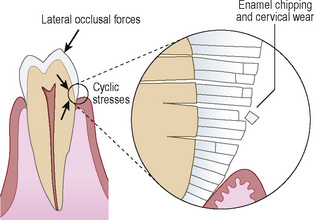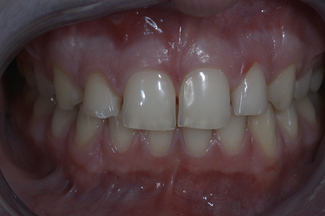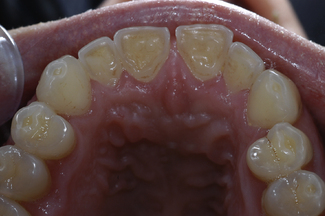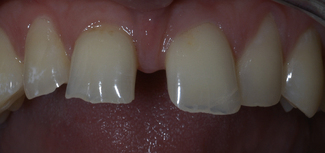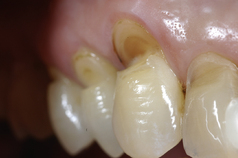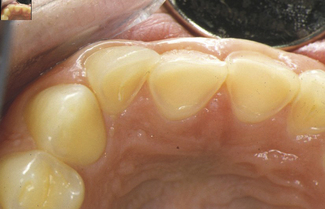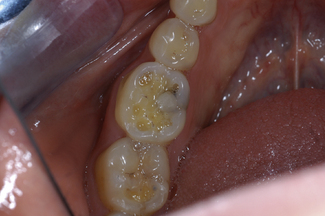Chapter 4 Tooth wear
Definitions
Clinical appearance
Anterior teeth
In the early stages of wear the anatomical features of the tooth become indistinct and lose features such as mamelons (Figure 4.2). Erosion results in a glassy appearance, particularly on the facial/buccal surfaces of the upper anterior teeth. As the condition deteriorates, the effects become more pronounced and widespread. Early stages involving enamel wear can be difficult to identify, particularly around the cervical margins of teeth. Localized and extensive lesions limited to enamel will be visible but generalized changes can sometimes be difficult to assess.
Once dentine is exposed, the difference in colour compared with enamel will make the diagnosis clearer. On the palatal surfaces of upper anterior teeth the complete loss of the enamel exposes the dentine, giving the characteristic appearance of perimolysis (Figure 4.3). This is a condition that can arise from chronic vomiting or regurgitation. It is also thought that the rough surface of the dorsum of the tongue may act as an acid reservoir and an abrasive, increasing the tooth wear and producing the characteristic highly ‘polished’ palatal surfaces with a rim of enamel (Figure 4.3). If the wear process proceeds, the gradual undermining and thinning of the incisal edges of the teeth causes fractures of the enamel and dentine and increases the translucency. The presence of incisal translucency is indicative of a late stage and signifies considerable tooth wear on the palatal surfaces of the upper anterior teeth (Figure 4.4).
Wear along the cervical surfaces of teeth is often mistakenly referred to as abrasion. However, the abrasive nature of modern toothpastes and toothbrushes makes abrasion unlikely. Mechanical wear will occur with overzealous brushing but the formation of V-shaped lesions along the cervical margin (Figure 4.5) is often related to a combination of abrasion and erosion. Historically, textbooks have shown images of rare causes of abrasion, such as that from pipe smoking or where seamstresses have used their teeth to cut thread. However, in today’s society, there is a new threat that the dentist needs to be aware of: body piercings. Figure 4.6 shows the amount of tooth wear that has occurred due to the parafunctional chewing of a tongue piercing. Such piercings have also been the cause of other intraoral complications such as gingival recession.
The presence of staining on enamel or dentine can give an estimation of the progression of erosive tooth wear. A stain-free surface can suggest that any acid erosion is active whilst a stained surface suggests the process is inactive. The successful implementation of dietary controls will have an effect on the progression of erosive tooth wear, with the teeth becoming progressively more stained as the process becomes inactive (Figures 4.7 and 4.8).
Molar teeth
In the early stages discrete circular cavities may appear on the occlusal surfaces of molar and premolar teeth. These cavities, unlike caries, are hard and have a halo of whitened enamel surrounding the deeper yellow of dentine (Figure 4.9). The cause of these lesions is normally associated with erosion but some contribution from abrasion may also be possible. This is often referred to as ‘cupping out’ of the cusp tips, but may also be seen in relation to the incisal edges of the anterior teeth. If the process deteriorates, the discrete cavities join and the lesion increases in size. If the erosion is rapid and severe, the cusp tips or incisal edges of one or more opposing molar, premolar and/or anterior teeth may appear not to meet on closure into the intercuspal position (Figures 4.10 and 4.11) and, where present, gold, amalgam or composite restorations appear to be proud as the surrounding tooth structure wears at a greater rate than the restoration (Figure 4.12).
Stay updated, free dental videos. Join our Telegram channel

VIDEdental - Online dental courses


